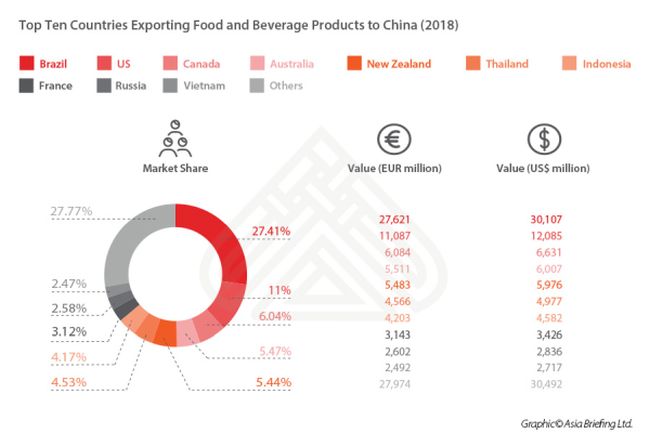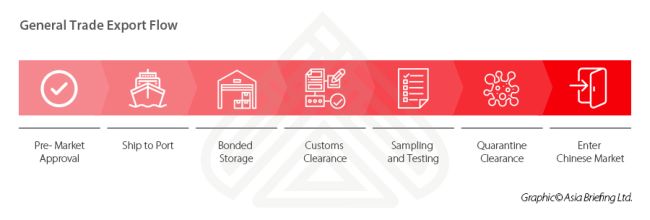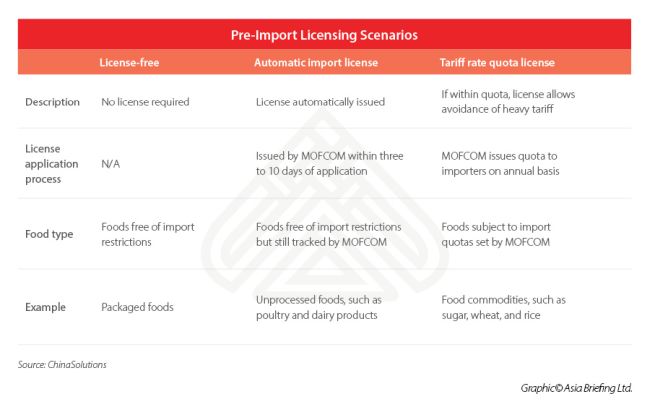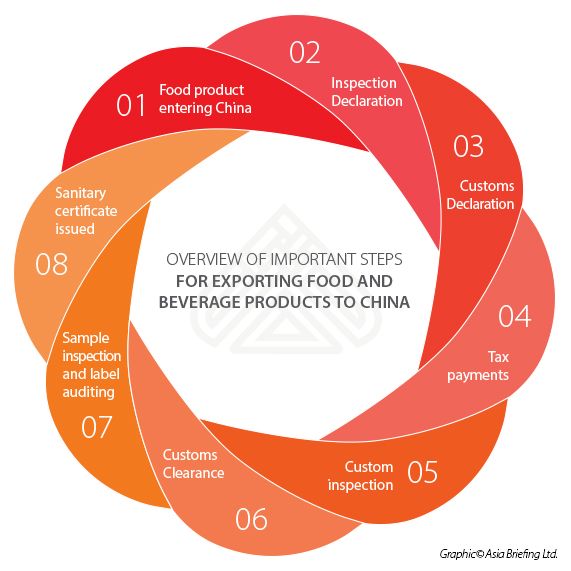- China has a multi-layered food regulatory system to ensure the quality and safety of imported food items.
- Every year, however, a large amount of food imported into the country is either returned or destroyed due to lack of compliance or irregularity in food quality, causing significant loss to both importing and exporting companies.
- In times of greater transgression, the import license may be revoked and the companies may be barred from future trade.
- Keeping in mind the high business risks involved, companies must stay abreast of the latest food regulations and ensure the conformity of the products to the necessary import procedures.
China became the world's second largest buyer of imported food and beverage (F&B) after the US in 2016.
Its total imports exceeding AU$130 billion (US$88.2 billion) according to data cited by the Australian Trade and Investment Commission (Austrade).
In 2018, that figure increased to US$110 billion; the largest F&B exporters to the Chinese market were Brazil, the US, Canada, Australia, and New Zealand.
China's appetite for imported F&B is still growing and diversifying with its economy shifting towards consumption-driven growth.
General Administration of Customs of China (GACC) data shows that over the last decade, China's food import trade grew at an average annual rate of 17.4 percent.
By 2019, there were 2,283 kinds of imported foods from 176 countries and regions incorporated into China's market access management system.

Yet, despite the lure of its huge market, exporting F&B to China is not easy.
China has a multi-layered F&B regulatory system to ensure the quality and safety of imported goods.
The country's F&B safety is supervised by multiple government agencies and departments, mainly the State Administration for Market Regulation (SAMR), the National Health Commission of China (NHCC), and the GACC.
Each year, a large number of foreign F&B firms and exporters fail to access the Chinese market due to insufficient compliance.
Between January and July 2019, a total of 727 batches of foreign F&B items were returned or destroyed due to a lack of compliance in food quality, certificates, label, and package, excessive or limited use of food additives, presence of micro-organisms, no access for inspection and quarantine, non-compliant ingredients, and other reasons.
This causes significant loss to the whole food and beverage supply chain. In worst case scenarios, the import license of the importing trading company is revoked, and their investors barred from carrying on future trade.
In such a strictly regulated environment, where consumers and the government are quick to welcome the next company in line, the stakes are clearly high.
Food conformity and compliance with import procedures should thus be prioritized for all businesses keen on selling to the Chinese market or considering it.
In this article, Dezan Shira & Associates and the Silk Initiative introduces some of the many certifications, regulations, and procedures required to export food products to China.
Step 1: Complete the importers and exporters registration
Foreign exporters usually adopt two ways to get goods to China: general trade export or cross-border e-commerce (CBEC).

In either model, all exporters and importers of foreign F&B must be recorded through the "Registration Systems of Imported Food and Cosmetic Importers and Exporters" (http://ire.customs.gov.cn) or the "Internet + customs platform"(http://online.customs.gov.cn/) of the GACC.
If the foreign exporter wants to choose a Chinese importer of record to conduct customs clearance (and quarantine if required), the exporter is advised to use China's credibility system to gather basic official information about the prospect importer or review the importer's performance via a public register maintained by the GACC.
In addition, some of the food products that have heightened safety requirements, such as meat and health products, require additional registration.
To illustrate, if the food product being exported is on the List of Food Imports Subject to Enterprise Registration (full list in Chinese available here), the foreign manufacturer of the certain product must register with the China's Certification and Accreditation Administration (CNCA).
If the foreign manufacturer is deemed as meeting Chinese registration requirements, it will be publicly listed on the CNCA (http://www.cnca.gov.cn/bsdt/ywzl/jkspjwscpqzc/) website. The registration will be valid for four years and is extendable.
Further, to be noted, as of October 2012, it is mandatory for exporters to register each shipment of food products online with the General Administration of Quality Supervision, Inspection and Quarantine (AQSIQ) department for tracking purposes.
Step 2: Prepare documentation, pre-import licensing, and trademark registration
Documentation needed to clear customs
China has strict and complex documentation requirements for most food products imported into the country.
Before shipping the products, entities are required to submit properly documented information on quality, quarantine, origin, and import control, along with a detailed packaging list and a description of the packaging material, among other documents.
These documents are reviewed only after the shipment reaches China. Therefore, the entity must ensure that all documents are complete and authentic to avoid any delay and storage costs.
Entities can use the Harmonized System (HS) codes available on the China Customs' website to check the category of the product, the associated import tax rates, documentation, licenses, and testing requirements (the HS nomenclature is the international system used for categorizing all products traded between countries).
Although the documentation requirements vary between products and product categories, the exporter may prepare the following documents to import food products into China:
- Commercial invoice;
- A detailed packaging list;
- Bill of lading;
- Certificate for export from country of origin;
- Hygiene/Health certificate;
- Certificate of bottling date (for drinks);
- Certificate of free sale;
- Sample of original label;
- Sample of Chinese label; and
- Inspection certificate issued by AQSIQ.
Pre-import licensing
In general, food products entering China do not require pre-import licensing.
But if the product is included in the 2019 Goods Catalogue for Automatic Import License Management, such as poultry or dairy products, importers should apply for an Automatic Import License issued by the Ministry of Commerce (MOFCOM).
In addition, food items subject to import tariff quotas, such as wheat, corn, rice, and sugar are required to obtain the Agricultural Products Import Tariff Quotas Certificate.

Trademark registration
Since China only acknowledges trademarks registered within its own jurisdiction and follows the first-to-file system, registering the trademark in China is a key step for a foreign entity to protect its brand.
This is necessary if the firm wishes to avoid trademark squatters and disputes with local counterfeiters, which can result in reputational damage, losing customers and revenue as well as time-consuming and costly adjudication.
Foreign companies are recommended to file trademark applications with the Trademark Office of National Intellectual Property Administration (CNIPA) through a register agent – if they do not have a residency or place of business in China.
Step 3: Labeling
Every food product imported in China must be labeled in simplified Chinese characters to complete the Customs clearance. There are several rules specifying the labeling requirements on layout and content of F&B in China. Some of these include:
- Label rules for pre-packaged food (GB7718-2011, English and Chinese versions available here);
- Label rules for pre-packaged food for special dietary uses (GB 13432-2013);
- Label rules for pre-packaged food's nutritional labeling (GB28050-2011); and
- Label rules for pre-packaged alcoholic beverage (GB 10344-2005).
*GB refers to "Guo Biao" in Chinese here, meaning national standard.
In general, a label must provide the following:
- Standard name of foodstuff;
- List of ingredients as percentage;
- Name and address of manufacturers, local agent, or distributor;
- Production date, best before, end date, and guidance for storage;
- Country of origin;
- Quality grade;
- Code of national standard/industry standard for the production; and
- Special contents, if any.
All labels must be approved by the Chinese Inspection and Quarantine (CIQ) under AQSIQ. As label standards in China are subject to change, you are advised to consult experts to ensure compliance with the updated label requirements.
Joel Bacall, Senior Client Manager of food and beverage brand consultancy the Silk Initiative, further remarks that "while you need to ensure your product's labeling is compliant with Chinese regulations, you also need to consider how your products are packaged from a consumer and market perspective. For example, you will have to consider whether it's best to cover existing packaging with a new label, as well as how your competitors are re-designing their labeling to gain a competitive edge with the consumers in the market."
Step 4: CIQ, the food sanitary inspection, and customs clearance
Once the products reach China, the food products are inspected by Customs officials for review of relevant shipping documentation and labeling requirements.
The process is more complex for the first-time export. The procedure will be relaxed in the future after the first successful export.
Goods that pass customs clearance and inspection
The imported foods that pass inspection will be issued with a China Entry-Exit Inspection and Quarantine Bureau (CIQ) certificate by the GACC and be allowed to enter China. This certificate is issued for every shipment of product.
Goods without complete documentation
If the shipment misses any documents and Customs seizes it, the entity may either provide the missing documents or a CIQ declaration. To obtain a CIQ declaration, the entity must provide the following documents: business license, importing license, quota certificate, safety compliance declaration, an introduction to the company, and product information in detail.
Goods that fail customs clearance and inspection
Imported food that fails being cleared through Customs may undergo technical treatment under GACC supervision and then be re-inspected or be issued a Returns Handling Notice, meaning that the importer must return the product back to the exporter, or the goods have to be destroyed.

China offers many opportunities for global food exporters looking to enter a large and profitable market.
However, the country's food and beverage import process can be very hard to navigate for first time exporters, due to its fragmented and localized system.
Because of the country's vast geography, exporting to different locations within China will require due diligence to avoid administrative failure or incompliance.
Following the steps outlined above can make the process smoother and more effective, and seeking local advice from competent consultancies in the food and beverage space will ensure the company's success in one of the world's largest consumer markets.
(This article was originally published on June 13, 2017. It was last updated October 30, 2019.)
The content of this article is intended to provide a general guide to the subject matter. Specialist advice should be sought about your specific circumstances.
